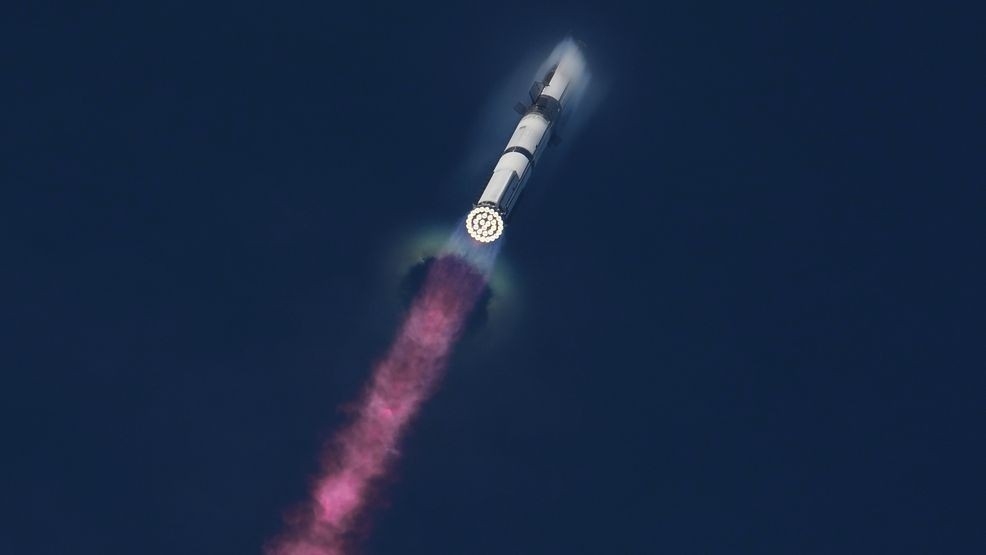Description
(TNND) — Mars is cold, has a very strong radiation environment, no magnetic field, a very low-pressure atmosphere, and it's all carbon dioxide, so you can't breathe there.
There are no nutrients to grow anything in the ground, said David Alexander, the director of the Rice Space Institute.
But we’re a step closer to sending humans to the Red Planet.
And that’s exciting to Alexander, Elon Musk and many others in the space community.
Musk’s SpaceX completed its most successful Starship test flight to date on Tuesday, launching from Texas, deploying a payload of dummy satellites, and returning the ship and booster to Earth with planned ocean splashdowns.
The capsule even successfully performed a flipped landing so that it hit the water nose up.
It was a crucial step in developing reusable spacecraft that will be important if we ever want to launch regular trips to Mars.
“The fact that they were able to launch and then return both parts and so on, I think that would count as a major step going forward,” Alexander said.
Musk has set his sights on Mars, with SpaceX planning a 2026 launch to the planet.
Is that a realistic timeline?
“In principle, yes, but what it can take is kind of, it's probably nothing more than a test flight, if they can reach that,” Alexander said.
SpaceX, which is also working with NASA on the Artemis III moon mission planned for 2027, is months behind schedule due to the lack of success, or at least the stepwise success, in the Starship test flights, Alexander said.
The SpaceX landing system that’s being tested is vital to NASA’s quest to return astronauts to the moon for experiments in a few years.
So, Alexander said that SpaceX has to fulfill its contracts with NASA.
“But, of course, they can chew gum and walk at the same time,” Alexander said. “I mean, they can do a couple of different things. So, it depends what they mean by getting to Mars. If it's getting the spacecraft up and then having enough fuel on it to put it into a trajectory to get us to Mars, but they don't care what happens when it gets there, that might be feasible for next year. Personally, I ... would not be surprised, let me say that, if it didn't happen in ‘26.”
The key to taking the next step is to demonstrate reliability in the Starship program. And that means repeating Tuesday’s successes.
“I don't think it'll be humans for a while,” Alexander said. “But if it's a payload and stuff, then that's still a high risk until they can show a little bit more reliability and get a few more test flights under the belt.”
SpaceX’s successes this week were good news for the space industry, Alexander said.
And it gets humans a bit closer to Mars.
“That's still one of the most exciting targets we have,” he said.
The first manned flight to Mars might be a flyby, he said.
That's probably the simplest thing they can do.
“And that's not even that trivial,” he said.
Alexander said he’d be surprised if it was an orbit insertion. And he’d really be surprised if it was a landing on Mars’ surface.
We don’t really have a good sense of how far away we are from potentially sending manned crews to Mars, Alexander said.
Refueling challenges need to be figured out, for one.
And we’d want to send all the resources, such as food and equipment, there ahead of time.
That process itself would take years and more innovation.
SpaceX says an ideal launch window for Mars opens up about every 26 months.
Alexander said Mars takes two years to go around the sun. The planetary bodies are constantly moving, and sometimes the sun is in the way. So, you have no communications for Mars flights, which would also take much longer.
Even when launching from the preferred window of planetary alignment, the trip to Mars would take six to nine months, Alexander said.
“It's a series of interesting challenges,” he said. “And I always say that people are like, ‘Wow, why are we even bothering to do it?’ But I think if we can solve these challenges, especially for humans, then there's 8 billion people on the planet that will benefit from those technologies."
The endeavor can benefit humanity, even if we don't ultimately colonize Mars.
The pursuit can fuel innovation and inspiration, he said.
SpaceX dreams of a city on Mars, calling it one of Earth's closest habitable neighbors.
Mars is only habitable if you have a closed-loop environment and take everything with you, Alexander said.
“it's not a habitable planet for us. Doesn't mean we can't live on it,” he said. “But it means that we're living on it in the form of, like, think about a submarine. ... The ocean is not habitable for us. But we can live in it, because we built a structure around us.”
Trips to Mars with temporary stays is one thing, he said. Establishing permanent residency on Mars is something completely different.
“We're talking hundreds of years for all of this, and we're not going to see it,” Alexander said. “But you don't get there without taking that first step.”
News Source : https://wfxl.com/news/nation-world/mission-to-mars-one-step-closer-with-spacexs-successful-test-flight-this-week
Other Related News
08/27/2025
WALB is working to produce a video for this story In the meantime we encourage you to watc...
08/27/2025
PEARSON Ga WALB - Leaders from the city county and state came together in Pearson to addre...
08/27/2025
ATLANTA Ga Atlanta News First - A student is in custody after a gun was fired in a bathroo...
08/27/2025
CORDELE Ga WALB - A South Georgia performing arts center is still suffering from the impac...
08/27/2025









